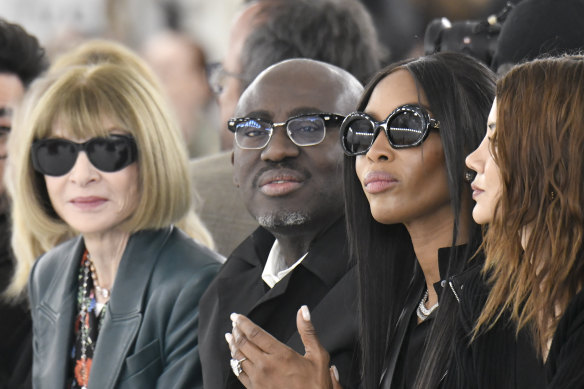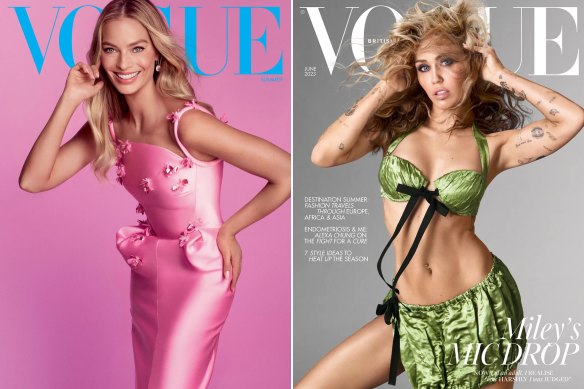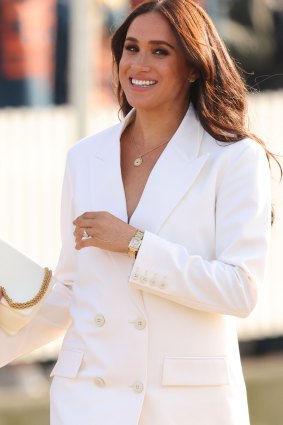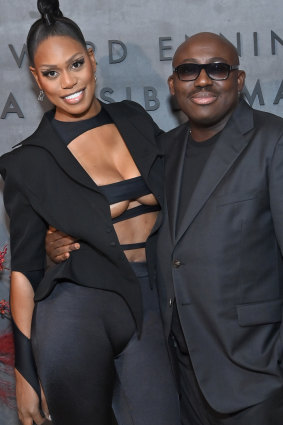By Ed Cumming
As the fictional Succession drew to a close on television in recent weeks, a real-life corporate succession drama was playing out in the fragrant hallways of Condé Nast. For years, a war has been simmering over the direction of Vogue, with the stakes nothing less than the future of the most famous magazine publisher in the world.
On one side was tradition, in the couture and sunglass-clad form of Anna Wintour, 73, Condé Nast’s chief content officer, who has been editor-in-chief of American Vogue since 1988. On the other, revolution, represented by Edward Enninful, 51, who since 2017 as editor of British Vogue has turned a staid old institution into a magazine driven by an increasingly radical agenda, with controversial covers and stories featuring transgender and disabled models and contributors. It was widely speculated that Enninful, a protégé of Wintour’s, would be the one to finally take over from her when she relinquished control.

US Vogue editor Anna Wintour and departing British Vogue editor Edward Enninful at the Loewe show, with Naomi Campbell and Vogue Australia editor Christine Centenera, in Paris in March.Credit: Getty
It hasn’t come to pass. On Friday, Enninful used a memo to staff to announce that he would be moving on from his role next year to become an editorial advisor and global creative and cultural advisor. In the message, he thanked Wintour and Roger Lynch, the chief executive of Condé Nast, “for their continued support,” while saying his new position would give him the “freedom to take on broader creative projects.”
Behind the scenes, the support is not so clear cut. According to some reports, Enninful’s decision was made at least in part because of a clash of ideas, with Lynch concerned about his progressive politics. At heart, Vogue is just another business, and as recent incidents at Nike, Bud Light, Disney and countless others have shown, the corporate world is an increasingly fraught place where you must strike a balance between selling your product and being seen to hold the “right” views.
When I interviewed Anna Wintour earlier this year, the big question was over her succession. I was warned that she was not a fan of retirement talk, but it seemed a valid point to raise. She is a grandmother of three, with nothing left to prove after one of the great careers in the history of journalism. Surely she couldn’t go on forever? We met on a sunny morning in New York, but the temperature in her office dropped a few degrees when I asked.
“I love my job,” she said. “I’m very fortunate. I can’t think of anything that would make me leave.”

The latest issue of US Vogue featuring Australian actor Margot Robbie promoting her ‘Barbie’ movie and Edward Enninful’s June issue for British Vogue with singer Miley Cyrus on the cover.
Perhaps we shouldn’t have doubted her. Those who have come up against Wintour have tended not to win. But few dispute that American Vogue is not the force it was, against a background of dwindling ad sales and print subscriptions. It was slow to take up the diversity cause with any urgency: it was only in June 2020, following the Black Lives Matter protests, that Wintour wrote an apology for not giving enough space to black voices.
Enninful, by contrast, seemed to present a credible changing of the guard, a working class gay black man in a world of mostly waspish heterosexual white women from upper class families. Replacing Alexandra Shulman, who had edited British Vogue for 25 years, Enninful recognised that things needed to change. He announced his reign with a blockbuster issue in 2017, that had the model Adwoa Aboa on the cover and featured Zadie Smith, Skepta, Sadiq Khan, Steve McQueen and Salman Rushdie as well as Kate Moss and Glenda Jackson. Out were the Sloaney archetypes, in was a broader vision of modern Britain.
As well as immaculate fashion chops (he started out as a stylist), Enninful had a contacts book bulging with famous friends. In the years since, he has cemented a reputation for diversity and activism. He featured the first trans contributor, Paris Lees, and cover star, Laverne Cox. Recent covers have featured disabled subjects. Last September he even featured a man, Timothée Chalamet, alone on the cover.
At the start of his career he described the evolving Vogue reader: “They are curious, they like to see the best the world has to offer,” he said. “They are predominantly women but in this day and age can we really separate the sexes? I’m a man working in a woman’s publication. Femininity sounds old fashioned.”

The 2019 issue of British Vogue, guest edited by Meghan, Duchess of Sussex, was a sell out on newstands.Credit: Getty
Advertisers were reportedly keen on Enninful’s new direction, which gave them the chance to be adjacent to a diverse, inclusive range of talent with right-on, social-media friendly messaging. It attracted hundreds of millions of pounds in advertising from companies like BMW. There were positive noises about circulation, too. Condé Nast can be opaque about its numbers, but Enninful’s Forces for Change issue in September 2019, which was guest-edited by the Duchess of Sussex and had Greta Thunberg on the cover, sold out in days.
For others, however, Enninful’s activism came at the price of an entertaining magazine. “Everything that made [Enninful] not a classical editor (that is to say, a trained journalist with a ‘words’ background) was why he flew so high early on,” wrote Farrah Storr, former editor of Elle, in a Substack post. “Vogue morphed from a playful, albeit slightly horsey, fashion magazine into a deeply political manifesto.” Along the way, she writes, people stopped buying it: instead it was given away or sold at a discount. “It was joyless, too political and seemed to have forgotten its role as a high-end shopping magazine.”
While Vogue is a particular case, fault lines around business and diversity are emerging across western businesses. Recently, Nike and Bud Light have attracted backlash from some quarters for paid partnerships with the trans activist Dylan Mulvaney. Nike had already made its position clear, most famously siding with Colin Kaepernick over taking the knee. Carhartt, a clothing company, was controversial during lockdown for requiring its employees to be vaccinated. All three businesses remain solvent. Disney, meanwhile, has been repeatedly embroiled with American conservatives – especially Florida Governor Ron DeSantis – over decisions like casting a black woman as the lead in the live action Little Mermaid and adding gay characters to films.

Edward Enninful with actor and trans-activist Laverne Cox at the September launch of his book “A Visible Man.”Credit: Getty
“It’s pivotal for businesses to have diversity, not only for the moral sense but the business sense, too” says Octavius Black, the chief executive of consultancy MindGym. Black co-founded his management consultancy with a psychologist, so knows a thing or two about behavioural science.
“We know that companies that are inclusive outperform those that are not. But some of these issues can become polarising, as it looks like certain protected categories compete with each other. Women’s rights and trans rights can come into conflict, as we’ve seen in Scotland,” he says.
“The risk is you’re appealing to a niche group and end up reducing your appeal to others,” he adds. “You want to be selling why your products are brilliant, and how you as a company are behaving responsibly and ethically in pursuit of that, but not taking a position on divisive social justice issues. You’d be unwise in America coming out for – or against – abortion, for example, which is not to say that it doesn’t matter, but it’s not the role of a company to take a position on those things.”
Insiders say that the contrast between Wintour and Enninful is also part of a bigger tension at Condé Nast over consolidating their resources. While editors in different territories once had more autonomy, increasingly things are run centrally from New York. It is expected that what works in Manhattan will work around the world. Britain has retained its freedom longer than most, but now even that is being eroded.
Progressive views on gender might help win over celebrities, publicists and advertisers keen to bask in a bit of reflected diversity on social media, but they do not necessarily play as well with the core readership. Vogue readers skew older and female, while readers in the new territories into which Condé Nast is keen to expand: such as the Middle East, India and China, may have more traditional views on social matters. The Enninful approach seems to have been deemed too great a risk.
He will not be replaced by another editor, but a “head of editorial content,” who will report to Wintour. Whoever takes it on will be inheriting a role with less of the prestige it once had.
“There are so many more joyless aspects to editing these days,” says Jo Elvin, who was editor of Condé Nast’s Glamour from 2001 to 2017. “Content is just seen as a marketing tool. When I started to hear conversations like ‘readers don’t mind if they’re reading paid content or not-paid content’, that’s when alarm bells started ringing. It’s language that takes the reader out of everything. The whole point of magazines is that you curate a personality and a distinct voice for that bunch of readers. I think [Enninful] has realised that his life could be even more fabulous.”
Being an editor is no longer about putting together a beautiful, well written magazine and keeping the advertisers sweet. You must convince advertisers that by being in your pages, they are also on the right side of history, while not allowing that to round off all the rough edges or put off any readers who don’t share your politics. At British Vogue, you have to do all that while reporting to the notoriously exacting Anna Wintour. Perhaps the real question is not who will succeed Edward Enninful, but why anyone would want to.
The Telegraph London
Make the most of your health, relationships, fitness and nutrition with our Live Well newsletter. Get it in your inbox every Monday.